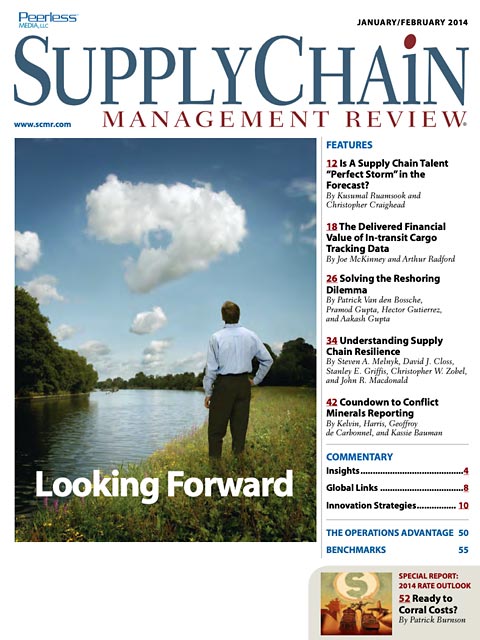Sorry, but your login has failed. Please recheck your login information and resubmit. If your subscription has expired, renew here.
January-February 2014
With the demands for more skilled supply chain professionals, the silver tsunami of retiring workers, and a shortage of supply chain students and instructors, a perfect storm may be brewing. Penn State authors Kusumal Ruamsook and Christopher Craighead outline the factors that may limit the pool of supply chain talent and offer five strategies to help weather the storm. Get this issue to learn more. Browse this issue archive.Need Help? Contact customer service 847-559-7581 More options
It’s not news that manufacturing in the U.S. has become more attractive in the past few years. And, even though there is no torrent of renewed manufacturing activity moving the needle just yet, it’s clear that the reshoring movement is growing. At the very least, it should make U.S. companies think twice about where they will manufacture their products in the next few years. But how do you figure out whether to jump on the reshoring bandwagon or sit this one out? There are a few tools and tests that can help you assess whether reshoring is the right choice. And if the answer is “Yes,” making sure your assumptions are realistic and you are factoring in all the moving pieces into your analysis is crucial to avoid any nasty surprises.
A number of macroeconomic factors have tipped the balance in favor of domestic manufacturing, at least for some industry sectors. Among them are the appreciation of China’s currency versus western currencies, China’s labor rate inflation, increased concerns about supply interruption, lower energy costs in the United States as a result of shale gas exploration, and a general push from federal and state governments to reduce the costs and administrative barriers of bringing manufacturing back.
Companies are responding: A growing number of reshoring cases, ranging from heavy machinery and appliances to chemicals, have been covered by the media in the past few months. Several recent studies have added even more fuel to the fire by identifying a number of industry sectors that, based on macroeconomic factors and industry cost models, should consider reshoring their operations. The usual suspects include computers and electronics, appliances and electrical equipment, primary metals, machinery, furniture, plastics and rubber, paper, and fabricated metals.
 |
This complete article is available to subscribers
only. Click on Log In Now at the top of this article for full access. Or, Start your PLUS+ subscription for instant access. |
Not ready to subscribe, but need this article?
Buy the complete article now. Only $20.00. Instant PDF Download.
Access the complete issue of Supply Chain Management Review magazine featuring
this article including every word, chart and table exactly as it appeared in the magazine.
SC
MR
Sorry, but your login has failed. Please recheck your login information and resubmit. If your subscription has expired, renew here.
January-February 2014
With the demands for more skilled supply chain professionals, the silver tsunami of retiring workers, and a shortage of supply chain students and instructors, a perfect storm may be brewing. Penn State authors Kusumal… Browse this issue archive. Access your online digital edition. Download a PDF file of the January-February 2014 issue.
 |
Download Article PDF |
It’s not news that manufacturing in the U.S. has become more attractive in the past few years. And, even though there is no torrent of renewed manufacturing activity moving the needle just yet, it’s clear that the reshoring movement is growing. At the very least, it should make U.S. companies think twice about where they will manufacture their products in the next few years. But how do you figure out whether to jump on the reshoring bandwagon or sit this one out? There are a few tools and tests that can help you assess whether reshoring is the right choice. And if the answer is “Yes,” making sure your assumptions are realistic and you are factoring in all the moving pieces into your analysis is crucial to avoid any nasty surprises.
A number of macroeconomic factors have tipped the balance in favor of domestic manufacturing, at least for some industry sectors. Among them are the appreciation of China’s currency versus western currencies, China’s labor rate inflation, increased concerns about supply interruption, lower energy costs in the United States as a result of shale gas exploration, and a general push from federal and state governments to reduce the costs and administrative barriers of bringing manufacturing back.
Companies are responding: A growing number of reshoring cases, ranging from heavy machinery and appliances to chemicals, have been covered by the media in the past few months. Several recent studies have added even more fuel to the fire by identifying a number of industry sectors that, based on macroeconomic factors and industry cost models, should consider reshoring their operations. The usual suspects include computers and electronics, appliances and electrical equipment, primary metals, machinery, furniture, plastics and rubber, paper, and fabricated metals.
 |
SUBSCRIBERS: Click here to download PDF of the full article. |
SC
MR

Latest Supply Chain News
- AI, virtual reality is bringing experiential learning into the modern age
- Humanoid robots’ place in an intralogistics smart robot strategy
- Tips for CIOs to overcome technology talent acquisition troubles
- There is still work to do to achieve supply chain stability
- Blooming success: The vital role of S&OE in nurturing global supply chains
- More News
Latest Resources

 Explore
Explore
Latest Supply Chain News
- AI, virtual reality is bringing experiential learning into the modern age
- Humanoid robots’ place in an intralogistics smart robot strategy
- Tips for CIOs to overcome technology talent acquisition troubles
- There is still work to do to achieve supply chain stability
- Blooming success: The vital role of S&OE in nurturing global supply chains
- Supply chain salaries, job satisfaction on the rise
- More latest news
Latest Resources

Subscribe

Supply Chain Management Review delivers the best industry content.

Editors’ Picks





